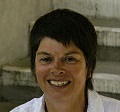1.8: Proteins
- Page ID
- 2373
Proteins are the third main group of organic compounds in the cell - in fact if you dried out a cell you would find that about 2/3 of the dry dust you were left with would consist of protein. Like carbohydrates and fats, proteins contain C, H and O but they all also contain nitrogen. Many also contain sulphur and phosphorus.
In the cell, proteins are an important part of the plasma membrane of the cell, but their most essential role is as enzymes. These are molecules that act as biological catalysts and are necessary for biochemical reactions to proceed. Protein is also found as keratin in the skin, feathers and hair, in muscles, as well as in antibodies and some hormones.
Proteins are built up of long chains of smaller molecules called amino acids. There are 20 common types of amino acid and different numbers of these arranged in different orders create the multitude of individual proteins that exist in an animal’s body.
Long chains of amino acids often link with other amino acid chains and the resulting protein molecule may twist, spiral and fold up to make a complex 3-dimensional shape. As an example, see the diagram of the protein lysozyme below. Believe it or not, this is a small and relatively simple protein.

It is this shape that determines how proteins behave in cells, particularly when they are acting as enzymes. If for any reason this shape is altered, the protein stops working. This is what happens if proteins are heated or put in a solution that is too acidic or alkaline. Think what happens to the “white’” of an egg when it is cooked. The “white” contains the protein albumin, which is changed or “denatured” permanently by cooking. The catastrophic effect that heat has on enzymes is one of the reasons animals die if exposed to high temperatures.
In the animal’s diet, proteins are found in meat (muscle), dairy products, seeds, nuts and legumes like soya. When the enzymes in the gut digest proteins they break them down into the separate amino acids, which are small enough to be absorbed into the blood.


